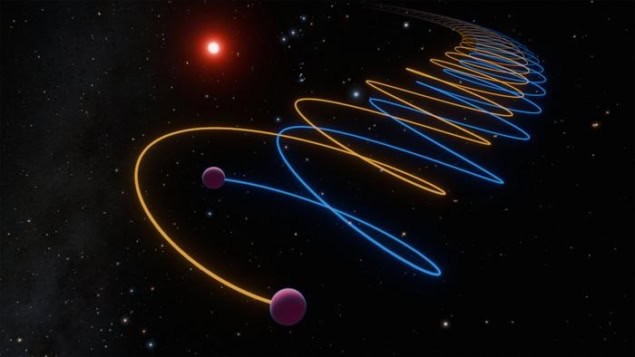
Two independent studies suggest that the brown dwarf Gliese 229 B is not a single object, but rather a pair of brown dwarfs. The two teams reached this conclusion in different ways, with one using a combination of instruments at the European Southern Observatory’s Very Large Telescope (VLT) in Chile, and the other taking advantage of the extreme resolution of the infrared spectra measured by the Keck Observatory in Hawaii.
With masses between those of gas-giant planets and stars, brown dwarfs are too small to reach the extreme temperatures and pressures required to fuse hydrogen in their cores. Instead, a brown dwarf glows as it radiates heat accumulated during the gravitational collapse of its formation. While brown dwarfs are much dimmer than stars, their brightness increases with mass – much like stars.
In 1994, the first brown dwarf ever to be confirmed was spotted in orbit around a red dwarf star. Dubbed Gliese 229 B, the brown dwarf has a methane-rich atmosphere remarkably similar to Jupiter’s – and this was the first planet-like atmosphere observed outside the solar system. The discovery was especially important since it would help astronomers to gain deeper insights into the formation and evolution of massive exoplanets.
Decades-long mystery
Since the discovery, extensive astrometry and radial velocity measurements have tracked Gliese 229B’s gravitational influence on its host star – allowing astronomers to constrain its mass to 71 Jupiter masses. But, this mass seemed too high and sparked a decades-long astronomical mystery.
“This value didn’t make any sense, since a brown dwarf of that mass would be much brighter than Gliese 229 B. Therefore, astronomers got worried that our models of stars and brown dwarfs might be missing something big,” explains Jerry Xuan at the California Institute of Technology (Caltech), who led the international collaboration responsible for one of the studies. Xuan’s team also included Rebecca Oppenheimer – who was part of the team that first discovered Gliese 229 B as a PhD student at Caltech.
Xuan’s team investigated the mass–brightness mystery using separate measurements from two cutting-edge instruments at the VLT: CRIRES+, which is a high-resolution infrared spectrograph and the GRAVITY interferometer.
“CRIRES+ disentangles light from two objects by dispersing it at high spectral resolution, whereas GRAVITY combines light from four different eight metre telescopes to see much finer spatial details than previous instruments can resolve,” Xuan explains. “GRAVITY interferes light from all four of these telescopes to enhance the spatial resolution.”
Time-varying shifts
Meanwhile, a team of US astronomers led by Samuel Whitebrook at the University of California, Santa Barbara (UCSB), studied Gliese 229 B using the Near-Infrared Spectrograph (NIRSPEC) at the Keck Observatory in Hawaii. The extreme resolution of this instrument allowed them to measure time-varying shifts in the brown dwarf’s spectrum, which could hint at an as-yet unforeseen gravitational influence on its orbit.
Within GRAVITY’s combined observations, Xuan’s team discovered that Gliese 229 B was not a single object, but a pair of brown dwarfs that are separated by just 16 Earth–Moon distances and orbit each other every 12 days.
And, after fitting CRIRES+’s data to existing brown dwarf models, they detected features within Gliese 229 B’s spectrum that clearly indicated the presence of two different atmospheres.
Frequency shifts
Whitebrook’s team came to a very similar conclusion. Measuring the brown dwarf’s infrared spectrum at different epochs, they identified frequency shifts which had not shown up in previous measurements. Again, these discrepancies clearly hinted at the presence of a hidden binary companion to Gliese 229B.

Citizen scientist discovers 34 brown dwarfs in binary systems
The two objects comprising the binary have been named Gliese 229Ba and Gliese 229Bb. Crucially, both of these bodies would be significantly dimmer when compared to a brown dwarf of their combined mass. If the teams’ conclusions are correct, this could finally explain why Gliese 229B is so massive, despite its lacklustre brightness.
The findings also suggest that Gliese 229 B is only the first brown dwarf binary yet discovered. Based on their results, Xuan’s team believe it is likely that binaries of brown dwarfs, and potentially even giant planets like Jupiter, must also exist around other stars. These would provide intriguing targets for future observations.
“Finally, our findings also show how complex and messy the star formation process is,” Xuan says. “We should always be open to surprises, after all, the solar system is only one system in billions of stellar systems in the Milky Way galaxy.”
The Caltech-led team describes its observations in Nature, and the UCSB team in The Astrophysical Journal Letters.



